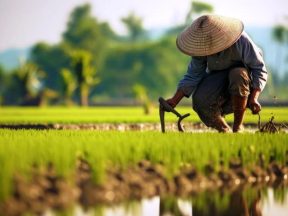Indo-Pacific. China-USA: An Ocean Apart.
If the “Pivot to Asia” – the strategic rebalancing of American interests from Europe and the Middle East to East Asia – was former President Barack Obama’s goal, it seems to be now more than ever US President Joe Biden’s mantra, given the bolder approach of the current administration to counter Chinese leader Xi Jinping’s increasingly assertive policy. This is happening not without jolts from Washington, which has pulled more than a few blows to its allies.
Firstly, for the lack of coordination with its historical allies on the hasty exit from Afghanistan, and then with AUKUS, the new pact between the United States, Australia, and Great Britain, whose announcement has infuriated France, which lost a massive submarine order. Not to mention the European Union, whose launch of the new Indo-Pacific strategy took place in the same days and was clearly overshadowed by the announcement of the tripartite pact.
To seal the new transpacific centrality was the recent QUAD summit, the quadrilateral security dialogue among the United States, Australia, Japan, and India. Dusted off in April, QUAD was recently celebrated on the 24th of September, when President Joe Biden received Australian Prime Minister Morrison, outgoing Japanese Prime Minister Suga, and Narendra Modi, the Indian Prime Minister, at the White House.
According to reports, Japanese Prime Minister Yoshihide Suga was the first to raise the issue of Beijing’s aggression in the Indo Pacific area, as well as the Taiwan issue. But Suga must not have felt alone, given the declaration issued at the end of the summit by the four heads of state and government according to which: “The area of the East and South China Seas is free and open, subject to international law, and free from any coercion. “The leaders also pledged to strengthen their security and prosperity.” China and its hostile acts towards its neighbours are not mentioned, but there is no doubt whom the message is addressed to.
At least one third of the world’s maritime trade goes through the South China Sea. Many studies refer to huge reserves of oil and natural gas, which are found under its seabed. Finally, it is a crucial area for the fishing and food survival of many countries.
As such, this is a key region, which China does not want to give up even for a strategic reason, as the area is considered as a sort of buffer zone in the event of a conflict with the United States.
Beijing claims to have secular rights to these waters and refers to an old, 1947 map of the Kuomintang Navy (the Chinese nationalist party), later adopted by the Communist Party. With the so-called nine-dash line, China claims about 90% of those waters, clashing with all the coastal countries: Vietnam, Malaysia, Brunei, the Philippines, and Indonesia, with which there is a long contention. Under pressure from President Obama, in 2015 Chinese President Xi Jinping promised not only restraint, but also that the Paracel and Spratly islands, the two most disputed archipelagos, would not turn into military bases.
This promise was not kept, as proven by several satellite photos. For instance, the part of the Spratly coral reef called Fiery Cross Reef, first used as an observation point, was transformed into an artificial island and subsequently into an operational base in the middle of the Pacific. In the Spratly archipelago alone, there seems to be 3000 acres of artificial land transformed by the Chinese into military bases, which have severely damaged the coral reef with consequent serious environmental damage.
In 2016, an Arbitral Tribunal in The Hague tried to clarify this, ruling that China cannot have claims on the waters in question or on the many disputed islets. A sentence to which, however, Beijing has given no value, and to which it has responded by strengthening its Navy, which has now become the largest in the world, and populating the waters of the Pacific Ocean with warships. Furthermore, taking advantage of the worldwide distraction caused by the pandemic, China has increased in number and intensity the incursions into Taiwan’s airspace, up to continuous provocations in recent days.
China’s growing military presence has irritated many of its neighbours, which are forced, under its influence, into a sort of a double game: fighting Chinese meddling under the table on the one hand whilst making the best of a bad situation on the other. A complex condition, which has in fact widened the scope for American diplomacy. During the Trump era, the US rejected all territorial claims of the People’s Republic, claiming China was “bullying and replacing international law”.
In less drastic terms, but on a similar note, the Biden administration seems to be trying to create a sort of containment belt around Beijing, which has taken decisive diplomatic action. In this context, the numerous and recent visits by the highest level of the US administration to the region are worth mentioning: Deputy Secretary of State, Wendy Sherman, went to Indonesia, Cambodia, and Thailand in June; Secretary of Defense, Lloyd Austin, visited Singapore, Vietnam, and Philippines last July; John Kerry, special envoy for climate, went to Japan at the end of August and to Tianjin in the People’s Republic. Vice President Kamala Harris traveled first to Singapore, perhaps the closest American ally in the region, and then to Vietnam, interested in receiving support in the South China Sea dispute.
The ideological proximity and the very strong commercial ties with Beijing do not allow Hanoi to make drastic choices, which leans on what can be defined as a dual-track strategy, aimed at maintaining excellent relations with both the PRC and US. For the United States, Vietnam remains a privileged partner in the region, not only for their important trade exchange (strongly skewed in favour of Vietnam, for which the US is the first outlet market for goods), but mainly for its geopolitical relevance. And it is no coincidence that Vietnam and Singapore are the only two countries in the region explicitly mentioned in the Interim National Security Strategy Guidance that the Biden
administration issued in March 2021.
Japan is concerned about the situation, as epitomized by its China Exit plan to incentivize Japanese companies to transfer production activities outside the territory of the People’s Republic. Tokyo is also very active in supporting Taiwan and has not failed to support the Hong Kong protests. It has also responded to the manoeuvres around the Senkaku / Diaoyu Islands, which Japan has controlled since 1895, but which Beijing contends with a dynamic that could be defined as mirroring that
of the South China Sea.
Directly proportional to the cooling of relations with Beijing is Canberra’s rapprochement with Washington. Australia has been increasingly troubled by the Chinese expansionism of the Xi era, which passed the first chain of islands that circumscribe the South China Sea (Japan, the Philippines, Taiwan, and Indonesia), entering the traditional Australian sphere of influence.
In 2018, after criticizing China’s penetration into its political system, Australia banned Huawei and ZTE from developing the national 5G network. They spared no criticism to Beijing on the violent process of assimilation of Uyghurs in Xinjiang and the repression in Hong Kong. Finally, Canberra was among the first to ask for an international investigation into the origin of the virus, to which China reacted with a drastic cut in supplies of Australian products, triggering a de facto trade war. It is therefore not surprising that Australia has tried to strengthen its ties with the United States, by far its most powerful ally and the only one truly capable of increasing its military arsenal, to counter Beijing’s hegemony in Asia.
India’s role is more complex and nuanced. Delhi is not directly involved in the South China Sea but remains a key regional power in Asia. Professor Harsh Pant from the ORF Foundation-India said that “the question of a closer relationship with the United States also passes through Afghanistan. The American departure from the country left Delhi more vulnerable. Actually, the Indian government has never had relations with the Taliban and had invested heavily on what was considered until last August Afghanistan’s legitimate government.
There are now fears of negative repercussions in Kashmir, which has always been an open wound in its relations with Pakistan. Prime Minister Modi is willing to help the United States, but in return he asks for “strong intelligence support to contain any terrorist attacks”. Delhi intends to continue supporting US policy through joint military exercises in the Pacific, while continuing to maintain tense relations with Beijing. There are therefore no conditions for India to take Australia’s clear-cut positions against Beijing.
A few months after Biden took office, Chinese leaders looked at the US hoping to leave the Trump era behind, but they had to acknowledge a renewed resolve by Washington on most key issues.The reaction to the announcement of the AUKUS alliance, condemned as irresponsible, and negatively judged by the Foreign Minister and State Councillor Wang Yi, was immediate and straight to the point: “AUKUS brings hidden danger to regional peace, stability and the international order.”
The day after the announcement of the tripartite pact, China requested to join the CPTPP – Comprehensive and Progressive Agreement for Trans-Pacific Partnership – a free trade agreement involving 11 countries, including Australia and Japan, which was originally conceived by former US President Barack Obama as an economic bloc to balance Beijing’s growing commercial power.
However, his successor Donald Trump had withdrawn Washington from the agreement. “The Chinese request to join the pact is an indication of strong concern for the coalition policy in the Indo-Pacific led by the United States”, Alan Yang, director of the Taiwan-Asia Exchange Foundation (TAEF), said “but it also highlights the void left by the Americans, and the fact that the very country against which this pact was born is able to ask for its accession. The CPTPP will be yet another battleground with Taiwan, which formalized the entry request
a day after Beijing.
CPTPP is a trade pact with clear rules and advanced standards, therefore Chinese state-owned enterprises with their international commitments linked to the Belt and Road Initiative (BRI) represent a clear obstacle to joining the project. Taiwan, being a model of good governance even in the economic field, should not face the same kind of problems.”
However, the tension between Beijing and Taipei goes far beyond trade issues, as the reunification with the mainland seems to be a clear goal of PRC leaders in a not-too-distant future. The recent intensified air incursions by Beijing military planes into Taiwan’s Air Defense Identification Zone (ADIZ), are just another message to Taipei.
Whether it is for economic-commercial or political-strategic dominance, the Sino-American rivalry is only destined to intensify in the coming years. Without necessarily resorting to an inevitable clash as foreseen by Graham Allison with his reference to the Thucydides’ trap, the Washington-Beijing opposition has now become the centrepiece of international relations. For the first time the pendulum of history has shifted from the transatlantic fault to the transpacific one, with all that that entails for our old Europe.
Francesca Baronio/ISPI



